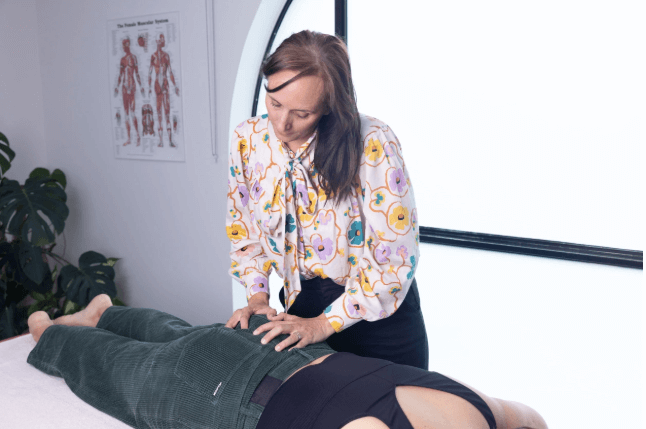
Osteopaths take a whole body, whole person approach to treating coccyx pain.
Do you have coccyx (tailbone) pain? You may have tried stretches or a donut cushion or maybe you’ve even resorted to steroid injections, but nothing seems to help. If this is you, perhaps you would benefit from a whole body, whole person approach to your coccyx pain.
Coccyx pain can be caused by many different things, which is what makes it hard to treat. One thing that is often overlooked is how the surrounding muscles, bone, ligaments and nerves can interact to create your coccyx pain.
This is something that Osteopaths think about when we’re treating coccyx pain.
What does an Osteopath do for coccyx pain?
Osteopaths can do hands-on treatment to your coccyx. But they don’t stop there. The coccyx is affected by many different muscles, ligaments, fascia, joints and nerves. We want all the structures that could affect your coccyx to move well. We find that taking a whole body, whole person approach is far more effective for our patients.
Why is a whole-body approach important when treating coccyx pain?
Let’s consider the foot as an example. The connection between the foot and coccyx is more involved than you might think. Firstly, nerve supply plays a role: the same nerves that reach the base of the foot also extend to the skin around the coccyx. Some theories suggest that increased sensitivity in one area may lead to increased sensitivity in the other.
Secondly, the role of fascia is crucial. Fascia is a continuous sheet of connective tissue covering every muscle, bone, nerve, and organ, linking various parts of the body. It’s essential for transferring forces across the body. If one area, such as the foot, is tense or fails to absorb forces effectively—such as the impact when your foot strikes the ground while walking—this can lead to increased force flowing up to areas above the foot, including the knee, hip, and pelvis.
The coccyx is an important part of transferring force through the pelvis up to the back, meaning that forces not absorbed correctly by the foot may be transmitted through the ligaments and muscles that surround and attach to the coccyx, potentially causing coccyx pain. This connection helps explain why some individuals develop coccyx pain gradually, even without an initial injury.
What osteopathic techniques are used to treat coccyx pain?
Osteopaths use a three-pronged approach when treating coccyx pain using a mix of hands-on therapy, exercise and education.
- Hands-on therapy is used to help your coccyx and the rest of your body to move better by reducing muscle tension, improving joint mobility and helping to modulate pain inputs.
- Exercise is about how you move outside the treatment room. Osteopaths help you learn what exercises may be helpful to improve your strength and mobility and/or they can guide you to professionals or programmes that assist you to build long-term strength and mobility.
- Education is an essential element of osteopathic care. It is important for you to understand why your pain started and what strategies you can use to reduce, manage or eliminate it. These strategies may include props, such as pillows, breathing techniques, pain education, sit to stand postures among others. Osteopaths tailor the education to your particular needs and goals.
Coccyx pain is literally a pain in the butt. It can be difficult to treat and can be a cause of great frustration in many of our patients’ lives. While osteopaths cannot guarantee results, they have successfully worked with many people with coccyx pain.
This blog has been reproduced with the permission of Dr Elizabeth (Liz) Johns (Osteopath) at The Pivot Osteopathy.
Disclaimer: This blog is for general informational purposes only and does not constitute the practice of medicine, osteopathy, nursing or other professional health care services, including the giving of medical advice, and no practitioner/patient relationship is formed. The use of information on this blog or materials linked from this blog is at the user’s own risk. The content of this blog is not intended to be a substitute for professional medical advice, diagnosis, or treatment. Users should not disregard, or delay in obtaining, medical advice for any medical condition they may have, and should seek the assistance of their health care professionals for any such conditions.
